There’s dizzying evidence of the unlivability of Canada wherever one looks. That NDN kids, NDN women and men, queer and trans NDNs are all enticed by the freedom of nonexistence is an ethical problem at the core of Canadian modernity. It’s worth noting that “the world” isn’t a passive noun, one given unto itself by way of common sense; rather, it’s a unit of power, and as such it harbours the toxins of history. NDNs, those against whom the world swelled into an oversized, self-destructive one, are made disproportionately susceptible to an existential sort of poison, to being suspended on the barbed-wire fence between life and death. That we haven’t sufficed in the project of making being in the world an arousing and joyous thing for all is a cause for alarm.
To begin to articulate what drives NDNs to kick-start a premature death, the conditions of which the state brews, we require a new grammar of living, one that foregrounds the fact of our utopian modes of being.
I tried to do just this in a poem I axed from This Wound Is a World, my first book of poems, about the eleven residents of the Attawapiskat First Nation who attempted suicide on April 9, 2016. I sought to paint an image of contorted living in a pocket of the world that engenders exhaustion as a symptom of governmental neglect. To infuse the body of he who takes his own life with a complex form of agency was a Herculean task I didn’t want to risk botching. There had to be another way to go about this, without the room for mishap that verse pried open. This, then, is an experiment in writing in the direction of a time and place that doesn’t produce suicide as a chronic condition, as a suitable response to trauma.
There’s a way to talk about and represent suicide that’s not pathologizing. The web series Feral follows the frayed lives of a host of twentysomething queer artists in Memphis, Tennessee, and does just this. Through a nonlinear, powerfully incoherent narrative style, Feral reveals bits and pieces of the doomed relationship of Billy (Jordan Nichols) and Carl (Ryan Masson). It’s slowly made clear that Billy and Carl are in the thick of a mode of loving that is profound and world shattering, so much so that it’s difficult to think of them as separate people. Each short episode carefully elaborates the festering sense Carl has that to stay, to be in a body, to say yes to life, is too exhaustive an undertaking. Billy refuses to give up, to move on, to make love elsewhere; this is the sort of beauty in the face of existential deprivation that’s especially useful now, in these dark times, in the fascist renaissance unfolding all over the West. Days before he takes his life, Carl whispers this to his boyfriend, who couldn’t be away from him, couldn’t let him go: “Please keep loving, Billy.”
This is an occasion not to romanticize suicide but to reflect on how to practise radical empathy for those who experience aliveness as a kind of everpresent death knell. Feral asks us to refuse to be entranced by easy fixes for the sicknesses of capitalist modernity, the corrective to which is an overthrowing of normal life. The series, in the end, posits love—queer, feminist—as what vitalizes the memory of the unjustly lost and functions as the foundation for a world that, like a benediction, is a promise of the glory of a dawning futurity. This is how we, those oppressed by normative gender and sexuality, fight on the side of hope, against suffering, against all that is against us and against hope.
I seek out a beauty that isn’t subject to interruption, a beauty free of contestation. The kind that manifests as performances of social life and embodiment that run counter to the world. Beauty as a troubling of normality. Beauty as an indictment of the status quo. Beauty as what it is to exist in the register of futurity.
At a reading, another poet says my love of beauty is abundantly clear. To be compelled to write beautifully about unbeautiful matters is a minor miracle, but it’s also to declare that the world has been poured onto me and that anyone within earshot has the power to wield a word like a match.
Nested at the mouth of the Attawapiskat River on James Bay, in northern Ontario, the remote Cree community of Attawapiskat is a pressurized site for the convergence of forces that stomp suffering into the rut of statistical truth. In one sense, suicide emerges as a political response to structurally manufactured sorrow where joy has been shut out of everyday life for a long time. The manufactured sorrows include inadequate and improperly constructed housing, overcrowding, state mismanagement, and so on. It should be unsurprising to those of us who attend to the long elaboration of colonial violence from coast to coast to coast that these sites for bad feeling are all propagated by a decades-long governmental project to suppress NDN vitality. We might think of these environmental stressors as grim reaper–like, foul things that feed on the happiness of us, one by one, until something like the soul has been picked clean.
What else would compel more than 100 people at Attawapiskat—whose population is only 1,549, according to the 2011 census—to try to end their lives between September 2015 and April 2016?
I write today on the side of joy, to expand its geographical confines against the tentacular ways the state and its gruesome history extinguish possibility in the lives of NDNs.
What do we owe the machine of living, which gushes its venom at the innocent? By innocent, I don’t mean those unscathed by politics, which is an impossible position to occupy. Purity is a misleading thing. With this troubled word—“innocence”—I want to nod to those in a brawl with the world as a consequence of what they signify in the arena of national sentiment. That any of us survive a world always against us, against what we signify and make imaginable, is a sociologically significant act.
What I know is that it’s unfair that NDNs are called on to make do in a world we neither wanted nor built ourselves. I have called this bind “precarity.” It’s also the ground zero for suicidal ideation.
The Neskantaga First Nation, in northern Ontario, has been under what is essentially a permanent state of emergency since 2013, as compromised living conditions continue to govern life and death there. In April 2016, after the aforementioned suicide attempts on a single Saturday, the Attawapiskat First Nation declared a state of emergency too. Liberal prime minister Justin Trudeau called the “news from Attawapiskat” heartbreaking, and Charlie Angus, the region’s MP and New Democratic Party Indigenous affairs critic, called it a “rolling nightmare.”
This governmental speak, this actionless language, does little to ameliorate the conditions that elevate suicide to a state of emergency. Emergency is a key word here, for it indexes a set of circumstances that call for an immediate end to the “rolling nightmare.” Emergency is a noun that yanks us from the normality of daily life, but its invocation also promises to grab us by the hand and lead us to safety. The addition of state of here is also important insofar as it butts up against emergency; it stretches the word out, which denotes its protracted nature, its velocity and scale. The emergency isn’t one emergency but a pileup of emergencies.
On the other hand, the state of emergency can be understood as a singular emergency: it is the emergency of Canadian history.
A country is an argument against beauty. Ocean Vuong: “I want to insist that our being alive is beautiful enough to be worthy of replication.”
How to be alive outside the affective register of the state, inside something less structurally sound, where to be lonely isn’t to ruinate?
Not every melancholic is buried in his longing. I want a song or a poem or a myth to drape over me like a fourth layer of skin. To be a gust of life, à la Roland Barthes, pirouetting throughout the world—how graceful!
The Cross Lake First Nation, in Manitoba, also declared a state of emergency, on March 9, 2016, in response to 140 suicide attempts in the preceding two weeks. An editorial in the McGill Daily argued that the so-called suicide crisis or suicide epidemic couldn’t be resolved without accounting for the region’s ecological harms and economic insecurity. NDN activists and scholars have similarly been quick to point out that the high incidence of suicide and suicidal ideation on reserves has everything to do with funding shortages for adequate and culturally safe mental health facilities, racism in urban centres that do offer services, and other forms of social and political violence. But Alex Wilson of the University of Saskatchewan also insisted that many of the youth from Cross Lake who attempted to or did take their lives were LGBTQ-identified and that this wasn’t being factored into public discourse.
Perhaps part of what overwhelms a more precise interrogation of the particularities of this NDN death drive is the way words such as emergency, crisis, and epidemic sensationalize rather than humanize those who exit the world. There’s a poetics to be tapped into that pries apart these concepts, one that disappears the mist of signifiers so as to allow us to conceptualize suicide as of a piece with the long war on NDN life. To prevent premature death, we are all beholden to doing away with uses of haunted speech.
On March 10 of that year, the Native Youth Sexual Health Network, a grassroots organization by and for NDN youth, which operates in the United States and Canada and for which I used to work, received an email from a family doctor stationed in northern Manitoba, pleading for help: he was worried that homophobia and transphobia weren’t being taken up in the mental health crisis-intervention strategies by the federal government and the band leaders. For many, the “suicide crisis” on reserves is a crisis of trans- and homophobia.
Suicide is routinely coated in negative affect, for it marks the loss of a life that could still be here. I, however, want to be able to talk about suicide both as devastating and as a kind of politically charged reaction to a world that makes living at the intersections of social loci untenable. Suicide prevention, then, can’t simply be about keeping NDNs in the world if it remains saturated by that which dulls the sensation of aliveness for those who are queer and/or trans and/or two-spirit. History and its ongoingness drove us to a point in which abandoning the world elbowed its way to the front of the line of individual agency. Suicide prevention thus needs to entail a radical remaking of the world.
In her beautiful and painful collection of songs and stories Islands of Decolonial Love, Leanne Betasamosake Simpson writes, “Suicide’s not something you do to other people, it’s something you do for yourself.”
Value judgments that smother suicide in shame extend the violence that stunted the lives of queer and trans NDN youth in the first place. If “suicide prevention” is the analytic we’re going to attach to, then it needs to be about making new forms of collective NDN life, ones that don’t cherry-pick some ways of being over others. Reserves can be incubators of transphobia and homophobia as a symptom of the Christianizing project carried out by settlers for decades; that history, however, doesn’t absolve NDNs from making use of a single-issue focus on race that ignores to a grievous degree the pain of the doubly and triply marginalized.
NDN youth, listen: to be lost isn’t to be unhinged from the possibility of a good life. There are doorways everywhere, ones without locks, doors that swing open. There isn’t only now and here. There is elsewhere and somewhere too. Speak against the coloniality of the world, against the rote of despair it causes, in an always-loudening chant. Please keep loving.
Excerpted from A History of My Brief Body by Billy-Ray Belcourt. Copyright © 2020 Billy-Ray Belcourt. Published by Hamish Hamilton Canada, an imprint of Penguin Canada and division of Penguin Random House Canada Limited. Reproduced by arrangement with the publisher. All rights reserved.





